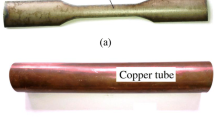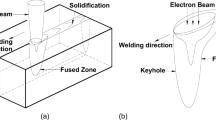Abstract
The heat rotary draw bending of large-diameter thin-walled (LDTW) commercial pure titanium (CP-Ti) tube is a highly nonlinear thermo-mechanical coupled physical process. Developing a reliable finite element (FE) model for this process is an effective way to investigate the heat loading and the complex bending behaviors. In this study, considering the characteristics of multi-die constraints and local heating, a thermo-mechanical 3D-FE model was established for preheating and heat bending of LDTW CP-Ti tube in terms of both accuracy and efficiency. First, using the static implicit algorithm, a preheating model was developed to predict the temperature distribution of bending tools. In this model, the key issues such as the full-sized geometry modelling, thermal interaction definition, and automatic heating control were solved to increase the simulation accuracy and efficiency. Then, introducing the predictions of preheating model and using the dynamic explicit algorithm, a thermo-mechanical coupled 3D-FE model was established for the heat bending simulation via the geometry modelling simplification, temperature definition of bending tools, realization of non-uniform temperature distribution, etc. Considering the temperature history of bending tools and wall thickness changing of bent tube, the reliability of preheating model and heat bending model was verified by several experiments. The results showed that the maximum relative errors of both predicted temperature and wall thickness changing degree were less than 9 %. Based on the reliable models, the effects of preheating temperature on the temperature distribution of bending tools and wall thickness changing of tube were numerically evaluated. The established model provides the scientific basis for the prediction and control of bending qualities of the heat RDB process, and the modeling method is also of general significance to the other heat-aided forming process.
Similar content being viewed by others
References
Lütjering G, Williams JC (2007) Titanium, 2nd edn. Springer, Berlin
Schweibold DJ (1992) Titanium tube bending for aerospace. Aircr Eng Aerosp Tec 61(8–11):29
Yang H, Li H, Zhang ZY, Zhan M, Liu J, Li GJ (2012) Advances and trends on tube bending forming technologies. Chinese J Aeronaut 25:1–12
Li H, Yang H, Liu K (2013) Towards an integrated robust and loop tooling design for tube bending. Int J Adv Manuf Technol 9–12:1303–1318
Zhang ZY, Yang H, Li H, Ren N, Tian YL (2011) Bending behaviors of large diameter thin-walled CP-Ti tube in rotary draw bending. Prog Nat Sci Materials International 21:401–412
Zhang ZY, Yang H, Li H, Ren N, Wang D (2013) Quasi-static tensile behavior and constitutive modeling of large diameter thin-walled commercial pure titanium tube. Mater Sci Eng A 21:401–412
Luo AA, Sachdev AK (2006) Moderate temperature bending of magnesium alloy tubes. US Patent: US 7 140 224 B2
Luo AA, Sachdev AK (2005) Development of a moderate temperature bending process for magnesium alloy extrusions. Mater Sci Forum 488–489:477–482
Luo AA, Sachdev AK, Mishra RK, Kubic RC (2005) Bendability and microstructure of magnesium alloy tubes at room and elevated temperatures. Magnes Technol 145–148
Wu WY, Zhang P, Zeng XQ, Jin L, Yao SS, Luo AA (2008) Bendability of the wrought magnesium alloy AM30 tubes using a rotary draw bender. Mater Sci Eng A 486:596–601
Wu WY, Jin L, Dong J, Peng LM, Yao SS (2010) Bending mechanisms in AM30 alloy tube using a rotary draw bender. Mater Manuf Processes 25:1359–1364
Li H, Yang H, Yan J, Zhan M (2009) Numerical study on deformation behaviors of thin-walled tube NC bending with large diameter and small bending radius. Comput Mater Sci 45:921–934
Jiang ZQ, Yang H, Zhan M, Yue YB, Liu J, Xu XD, Li GJ (2010) Establishment of a 3D FE model for the bending of a titanium alloy tube. Int J Mech Sci 52:1115–1124
Ren N, Yang H, Zhan M, Zhang ZY, Jiang HM, Diao KS, Chen XP (2013) Effect of weld characteristics on the formability of welded tubes in NC bending process. Int J Adv Manuf Technol. doi:10.1007/s00170-013-5015-9
Lazarescu L (2013) Effect of internal fluid pressure on quality of aluminum alloy tube in rotary draw bending. Int J Adv Manuf Technol 64:85–91
Goodarzi M, Kuboki T, Murata M (2007) Effect of die corner radius on the formability and dimensional accuracy of tube shear bending. Int J Adv Manuf Technol 35:66–74
Hao N, Li L (2003) Finite element analysis of laser tube bending process. Appl Surf Sci 208–209:437–441
Guan YJ, Yuan GP, Sun S, Zhao GQ (2007) Process simulation and optimization of laser tube bending. Int J Adv Manuf Technol 65:333–342
Hu Z, Li JQ (1999) Computer simulation of pipe-bending processes with small bending radius using local induction heating. J Mater Process Technol 91:75–79
Li XT, Wang MT, Du FS, Xu ZQ (2006) FEM simulation of large diameter pipe bending using local heating. J Iron Steel Res Int 13:25–29
Baudin S, Ray P, MacDonald BJ, Hashmi MSJ (2004) Development of a novel method of tube bending using finite element simulation. J Mater Process Technol 153–154:128–133
Huang BY, Li CG, Shi LK, Qiu GZ, Zuo TY (2005) Nonferrous metals engineering, first vol., In: China materials engineering canon. Chemical Industry Press Beijing. (in Chinese)
Gan Y, Tian ZL, Dong H, Feng D, Wang XL (2005) Steel materials engineering, second vol., In: China materials engineering canon. Chemical Industry Press, Beijing. (in Chinese)
Yang H, Wang M, Guo LG, Sun ZC (2008) 3D coupled thermo-mechanical FE modeling of blank size effects on the uniformity of strain and temperature distributions during hot rolling of titanium alloy large rings. Comput Mater Sci 44:611–621
Bai Q, Lin J, Zhan L, Dean TA, Balint DS, Zhang Z (2012) An efficient closed-form method for determining interfacial heat transfer coefficient in metal forming. Int J Mach Tool Manu 56:102–110
Lee RS, Lin HC (1998) Process design based on the deformation mechanism for the non-isothermal forging of Ti-6Al-4V alloy. J Mater Process Technol 79:224–235
Author information
Authors and Affiliations
Corresponding author
Rights and permissions
About this article
Cite this article
Zhang, Z., Yang, H., Li, H. et al. Thermo-mechanical coupled 3D-FE modeling of heat rotary draw bending for large-diameter thin-walled CP-Ti tube. Int J Adv Manuf Technol 72, 1187–1203 (2014). https://doi.org/10.1007/s00170-014-5709-7
Received:
Accepted:
Published:
Issue Date:
DOI: https://doi.org/10.1007/s00170-014-5709-7




